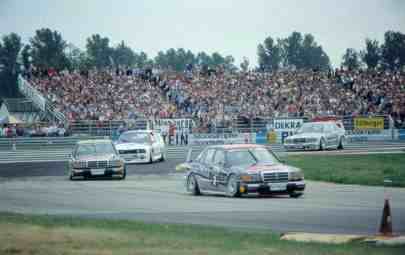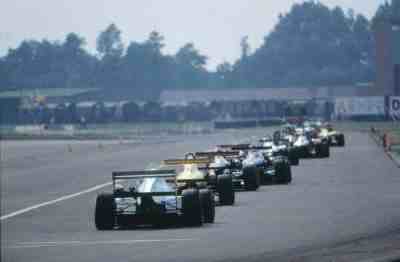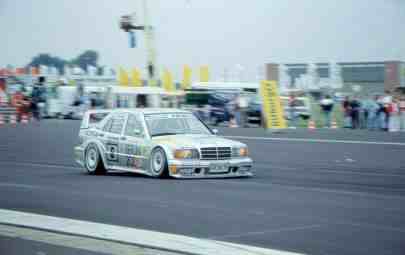back
Airfield Diepholz Racetrack
History and photos by Dieter C. Serowy

The Airfield Diepholz is located in Lower Saxony, a northern part of Germany. It
was built in the 1930s and used as a german airbase in the Second World War. The
airfield was destroyed in the war and got rebuild as a military airbase in the 1950s.
The German Airforce still uses the airfield.
The german motorsport in the 1960s suffered very much from a lack of circuits. The
old N¸rburgring and the 1966 opened new Hockenheim-Motodrom were the only two
permanent race tracks at that time. Looking for alternatives, races on military airfields
became quite popular. Untill the 1990s, tracks like Wunstorf, Mainz-Finthen, Kassel-Calden,
Fassberg or Siegerland were used for german championship races. But the most popular
airfield-race in Germany used to be at Diepholz.
In 1968, the local motorsport-club AMC Diepholz organized the first "ADAC-Flugplatzrennen
Diepholz". The anual event soon became quite popular, due to the fact that race-director
Peter Rumpfkeil and his team not only proved to be able to well-organize the races
but also to bring the stars of international motorsport to Diepholz.
From the start of the championship in 1972, the Diepholz-Race was
included in the "Deutsche Rennsport-Meisterschaft" (DRM), the most famous
touring-car-championship of the 1970s. The best touring-car-pilots of that time -
like Dieter Glemser, Frank Gardner, Hans Heyer, Toine Hezemans, Helmut Kelleners,
Karl-Heinz Becker, Bob Wollek or Albrecht Krebs - raced at Diepholz. 1977 saw one
of the most spectaculous races in the history of Diepholz: In that season, BMW and
Ford battled in the DRM. The Bavarians ran three works-cars with the youngsters Eddie
Cheever, Marc Surer and Manfred Winkelhock - the so-called "BMW-Junior-Team".
Their appearences were sucessful but the youngsters got a bit wild on the track.
At the Norisring-race, Surer attacked Ford-driver Hans Heyer in such a brutal way
that both cars were totally smashed. BMW Motorsport-Director Neerpasch wanted to
cool things down and for the Diepholz-race the "Junior-Team" was replaced
by the "Gentleman-Team"- Hans-Joachim Stuck, Ronnie Peterson and David
Hobbs. Bad luck for Neerpasch, Stuck and Peterson didn't act like elder statesmen
of motorsport. In the pouring rain they had their private battle which ended almost
dramaticly: Peterson missed his breaking point at the end of the s/f-straight, hitting
some water-tons, smashing his BMW 320 and stopping just some centimetres away from
the spectators. Many other drivers spun on the slippery track and it was Hans-Joachim
Stuck who won after an error-free race.
After this race - and the Peterson-incident - there was a lot of criticism in the
press about safety at Diepholz. And the teams complained about the damaged cars.
At that time, the chicanes in Diepholz were marked by old watertons and old tyres
- hitting either of them meant a lot of work for the mechanics. So the DRM decided
not to return to Diepholz in 1978. Peter Rumpfkeil had to come up with a new idea
- and he did: He brought 20 Chevrolet Camaro from Sweden to Diepholz for the "Camaro-Supercup
1978". And of course he managed to have drivers like Stuck, Mass and Stommelen
in those cars. The fans were enthusiastic and the show was perfect. And in 1979 the
DRM returned to Diepholz....
At the end of 1980 the DRM seemed to face a crisis for 1981. And so Rumpfkeil cancelled
the DRM-races in favour of having an outstanding one-off event: The "German
Race of Champions". The entry-list of that race in 1981 is a who-is-who of motorsport
at that time: F1-Champion Alan Jones, John Watson, Hans-Joachim Stuck, Hans Heyer,
Rally-Champion Walter Röhrl, Björn Waldegaard, Michele Mouton and many
more. On identical cars - Ford Escort XR3 - they offered brillant entertainment for
the fans at Diepholz and on TV. And it was Hans-Joachim Stuck who proved to be the
Champion of the Champions, winning the race.

In 1983 the Group-C-Sportscars made their first appearence on the airfield. The Porsche
956 and 962 Turbo, the most impressive Sauber-Mercedes C9 Turbo and Nissan Turbos
remain as the fastest cars ever to race on this track - cars with up to 900 hp. But
a new german touring-car-championship called "Deutsche Tourenwagen-Meisterschaft"
(DTM) soon proved to be more popular than the powerful sportscars. The DTM raced
at Diepholz in 1984 and 1985, but it all ended up in a scandal. The touring cars
had to have noise-reduction but Rumpfkeil wanted to have racing-sounds on the airfield.
So he encouraged the teams to run the cars without noise-reduction-exhausts. Some
teams did, others did not. There were protests, Rumpfkeil got in trouble with the
national motorsport association and Diepholz lost the DTM-races until 1989.
When the DTM returned in 1989, the circuit had changed: The old watertons and tyres
had gone. They had been replaced by plastic-kerbs, which were installed especially
for the race-weekend and which were removed afterwards. The track-layout had also
changed. Up to 1996 - the last year of the DTM - Diepholz was part of the championship.
Still it was a non-permanent race-track and it was a huge amount of work necessary
to keep the DTM-race: e.g. installing stands for the spectators, the kerbs, barriers,
the paddock. In 1996 Rumpfkeil and his team even had to add a gravel-trap at the
end of the s/f-straight. Still the teams had to improvise as there were no pit-buildings.
And the drivers had mixed emotions about the track itself with the superfast chicanes
on the s/f-straight.

About 60 000 spectators watched the races in 1996 - the biggest crowd ever. And it
was the last highlight in the history of the Diepholz-races. The DTM/ITC collapsed
at the end of the season. Meanwhile, Peter Rumpfkeil was the driving force behind
the new permanent circuit at Oschersleben and so the days of the races at Diepholz
were counted.
1997 saw the anual event take place with some minor races. The final curtain fell
in 1998 - exactly thirty years after the first race at the airfield.
On the Grid at Diepholz between 1968 and 1998:
- F1-World Champion Niki Lauda
- F1-World Champion Alan Jones
- F1 World Champion Keke Rosberg
- F1 World Champion Michael Schumacher, winner of the Diepholz F3-race in 1990.
F1 Race-winners who raced at Diepholz:
- Jochen Mass, Diepholz-winner in 1984
- Ronnie Peterson
- Clay Regazzoni
- John Watson
- Michele Alboreto
- Jacques Laffite
- Alessandro Nannini
- Heinz-Harald Frentzen, winner of the Diepholz F3-race in 1989
- Ralf Schumacher, winner of the Diepholz F3-race in 1995
Other F1-drivers:
- Hans-Joachim Stuck, Diepholz-winner in 1972, 1974, 1977, 1980, 1981 and 1991
- Helmut Koinigg, Diepholz-winner in 1973
- Rolf Stommelen, Diepholz-winner in 1973 and 1977
- Tim Schenken
- Rupert Keegan
- David Hobbs
- Harald Ertl
- Jo Gartner
- Manfred Winkelhock
- Stefan Bellof, winner of the Diepholz F3-race in 1981
- Volker Weidler
- Joachim Winkelhock, Diepholz-winner in 1990
- Christian Danner
- Bernd Schneider, Diepholz-winner in 1994 and 1996
- Mauro Baldi
- Jean-Louis Schlesser, Diepholz-winner in 1988
- Michael Bartels, Diepholz-winner in 1995
- Nicola Larini, Diepholz-winner in 1993
- Yannick Dalmas
- Johnny Cecotto
- Emanuele Pirro
- Allen Berg
- Dieter Quester
- Martin Donnelly, Diepholz-winner in 1989
- Gabriele Tarquini
- Jan Magnussen
- J.J. Lehto
- Stefano Modena
- Giancarlo Fisichella
- Alexander Wurz
- Norberto Fontana
- Karl Wendlinger
- Pedro Lamy
- Jos Verstappen
- Jarno Trulli
- Nick Heidfeld
Other motorsport-stars at Diepholz:
- Arie Luyendjik (Winner of the Indy500)
- Walter Röhrl (Rally World Champion)
- Björn Waldegaard (Rally World Champion)
- Michel Mouton (first woman to win a world championship rally)
and Klaus Ludwig (three-times-winner of the 24 hours of Le Mans)
Ludwig scored seven victories at Diepholz.
e-mail to Dieter C. Serowy <DCSWY@aol.com>


